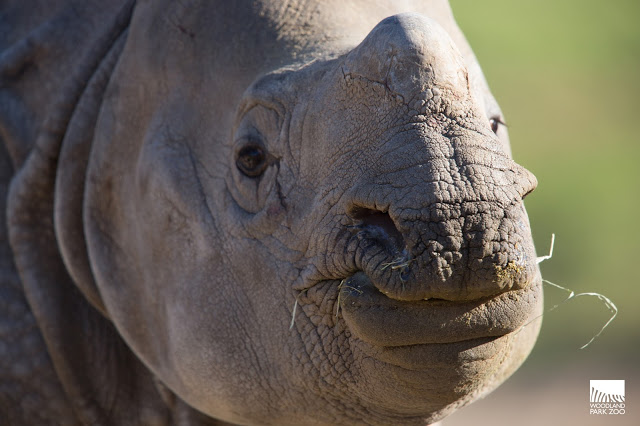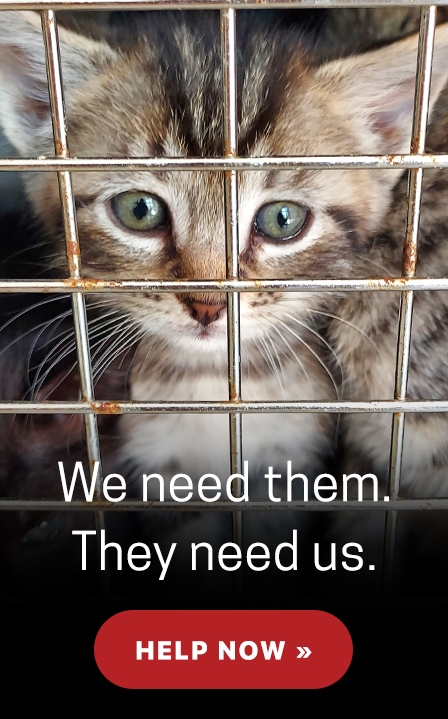In honor of National Zoo and Aquarium month, American Humane is celebrating Humane Certified™ zoological facilities and the incredible work they do to save species, provide life-saving research and education, and inspire millions of visitors each year to protect the animals that they see and interact with. The following blog post was submitted by Woodland Park Zoo.
In May 2018, Woodland Park Zoo opened Assam Rhino Reserve. In addition to a pair of young greater one-horned rhinos, Taj and Glenn, the exhibit is home to demoiselle cranes and Asian brown tortoises. Despite their difference in size, these species serve an equally important role in the zoo’s mission—to not only introduce you to these incredible animals, but to ask you to do your part in stopping wildlife trafficking and understand how human behavior impacts conservation efforts at home and abroad.
Greater one-horned rhinos
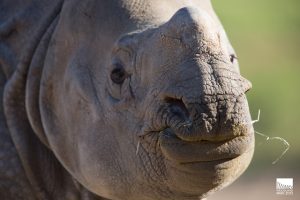
One of them is a huge fan of swimming and one of them loves to wallow in a fresh mud bath. One is described as curious and the other as adventurous. They weigh more than 1,800 pounds apiece, one-third what they will weigh when they are fully grown. They both have an incredibly cool armor-plated appearance. And they both represent far more than their own phenomenal presence.
They are remarkable, amazing, impressive, majestic, grand…and they are loved. Meet Taj and Glenn. While the two have more in common than not—they were even born just a day apart—they are unique rhinos with distinct personalities and preferences. As you get to know them, we want you to fall in love with these magnificent animals and their cousins in the wild.
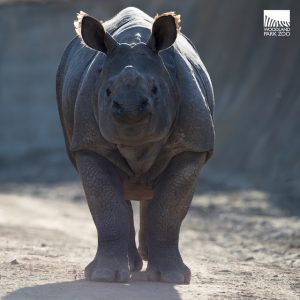
Greater one-horned rhinos live in northeastern India and southern Nepal. They can be found in the grasslands and forests, grazing on a wide variety of plants such as grasses, leaves, branches, fruit and aquatic plants. Primarily solitary, they communicate with scent, leaving marks on forest trails and in dung heaps. They are very fine swimmers, and even though they look bulky, they can run up to 34 miles per hour. These rhinos use mud wallowing to protect their skin from the hot sun and pests like ticks. At least 12 different communication sounds have been identified including snorts, roars, and honks.
Demoiselle cranes
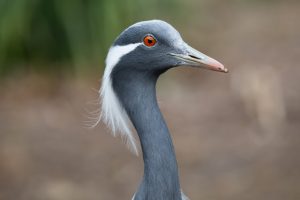
Ranging from central Eurasia to Asia and wintering in northeastern Africa and India, demoiselle cranes roost in the shallows of grassland lakes and wetlands. Their beautiful black, white and gray feathers make an especially elegant courtship dance. Though the smallest of crane species, these birds are large in population and range.
The migratory flocks are decreasing, however, due to threats such as hunting, habitat loss in part due to increased agricultural development, and pesticide use. The introduction of dams and drainage to existing wetlands are also risks to the crane’s natural habitat.
The name is believed to have come from Marie Antionette, who once named her pet crane “Demoiselle” which means “young lady” in French, to reflect its delicate and elegant appearance. The cranes are especially beautiful to watch as they preen, forage and display occasional performances as part of their communication in courtship or as a calming effect.
Asian brown tortoises
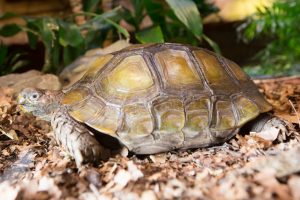
Native to southern and southeastern Asia, Asian brown tortoises inhabit moist and temperate tropical forests. The largest tortoise species in all of Asia, also known as the Asian forest tortoise, is crepuscular and can be found dining on grasses, herbs, fruit, and fungi during the cooler parts of the day at dawn and dusk. While these tortoises have thick, heavy shells to protect them from all sorts of predators including tigers, bears, foxes and monitor lizards—it is humans, who use the tortoise for food, traditional medicine, and pets—that pose by far the most significant threat. These, along with habitat destruction and hunting, are risks to an already fragmented population.
Asian brown tortoises can live up to 150 years old. They have large, tubercular scales on their thighs which sometimes grow so large it appears that the turtles have an extra leg—giving them the nickname of “six-legged tortoise.”
Conservation connections
Once found across the entire northern part of the Indian subcontinent, greater one-horned rhinos declined to fewer than 200 in the 20th century due to sport hunting, human conflict, poaching for their horns for use in traditional medicine, and habitat loss. According to the International Rhino Foundation, the population has recovered today to an estimated 3,600 thanks to conservation efforts and strict protection from Indian and Nepalese wildlife authorities and collaborative efforts of NGOs.
While these rhinos have a successful conservation story, the pressures of poaching remain high. Woodland Park Zoo supports the International Rhino Foundation’s Indian Rhino Vision 2020 project, which aims to see a wild population of greater one-horned rhinos in seven protected areas in India’s state of Assam by the year 2020.
Turtles and tortoises are being taken in unsustainable numbers at an alarming rate—both as food and for the pet trade. Woodland Park Zoo works with Turtle Survival Alliance which is a global network of zoos, aquariums and conservation organizations committed to saving turtles from extinction. Every visit to the zoo supports our efforts to protect precious turtle and tortoise habitats.
Woodland Park Zoo and International Crane Foundation work worldwide to conserve cranes and the ecosystems, watersheds, and flyways on which they depend. Your support directly protects these elegant cranes and ensures that their almost magical presence is not lost to future generations.
Thanks to public support, we can save species
The Assam Rhino Reserve exhibit at Woodland Park Zoo highlights the amazing adaptations of these three species and brings to life the impact of poaching, the illegal wildlife trade, and the turtle extinction crisis. While you visit with Taj and Glenn, learn about ways you can protect local wildlife here in the Northwest and advocate for rhino conservation around the world. We can’t save them without you.
The importance of public support through funding, collaboration and participation is more important than ever. In a global ecosystem, our impact on conservation action is only bolstered when everyone in the community is represented. This is a time of great change for zoos and aquariums.
The communities we serve are changing more than ever before, and we are trying to find new ways to reach underserved neighborhoods and make zoos and aquariums accessible to new communities. At Woodland Park Zoo, we are deeply committed to making our zoo inclusive for people of all backgrounds and abilities through a variety of programming and events. As we visit with the community and show our good work, we frequently hear from them an ongoing interest in finding ways to bring the zoo to the communities we serve. This is one of our primary goals in our new Strategic Plan and we intend to vigorously pursue it. This is particularly important when we receive such a high percentage of funding from our local governments here in Seattle and King County. We want to continue to show that our beloved zoo is accessible to all our residents—and we need everyone to stand up for saving wildlife and wild places.
Thank you for loving animals as much as we do—we hope you’ll visit Woodland Park Zoo to learn more about how we’re all in for animals.
Follow #RhinoLookout on our Facebook, Instagram and Twitter all summer to learn how you can look out for Rhinos. When you protect rhinos, you protect so much more.

